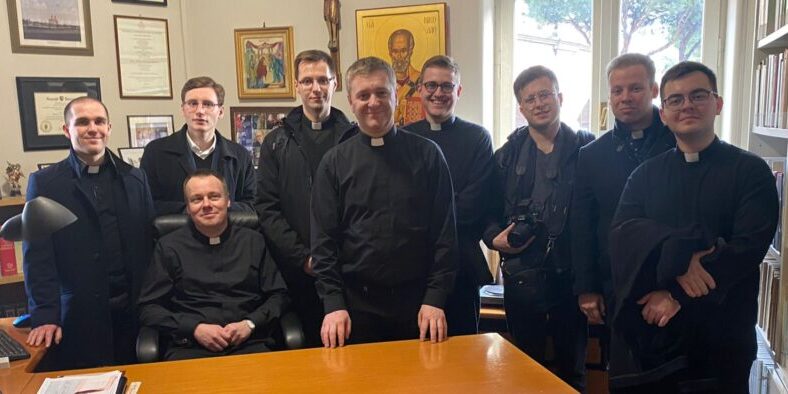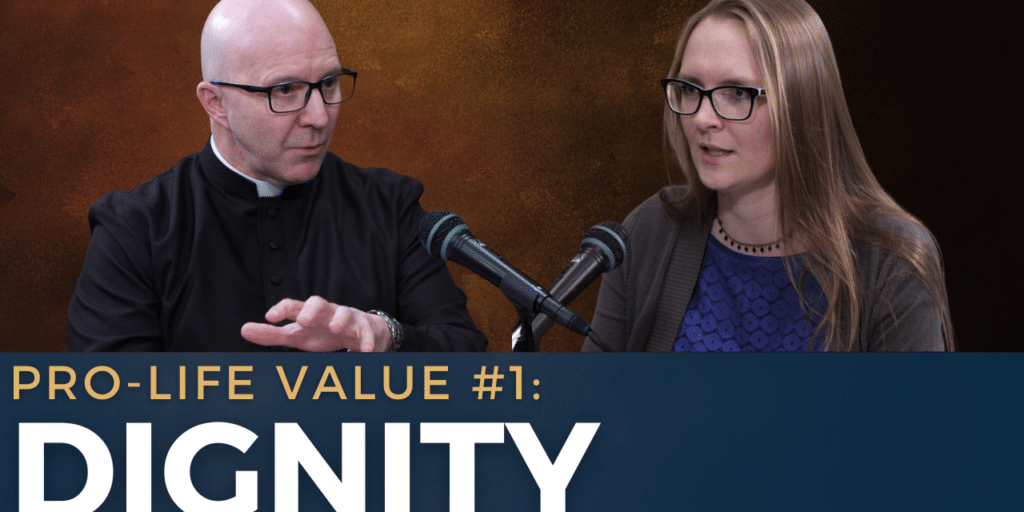Restoring Human Dignity at Christmas
Christus natus est! Christ is born!
From myself and everyone at Human Life International, I want to wish you a very Merry Christmas.
There is no feast day in the Church’s calendar that is more meaningful for me as a pro-life activist, or that brings me greater joy, than Christmas. Absolutely everything that we fight for every day here at Human Life International is encapsulated in those early chapters of the Gospels, and in that beautiful scene in Bethlehem.
It is no coincidence that Pope St. John Paul II starts his brilliant pro-life encyclical, Evangelium vitae, by recounting the Christmas story.
“At the dawn of salvation,” he writes in the second paragraph, “it is the Birth of a Child which is proclaimed as joyful news: ‘I bring you good news of a great joy which will come to all the people; for to you is born this day in the city of David a Savior, who is Christ the Lord’ (Lk 2:10-11).”
The Holy Father continues, “The source of this ‘great joy’ is the Birth of the Savior; but Christmas also reveals the full meaning of every human birth, and the joy which accompanies the Birth of the Messiah is thus seen to be the foundation and fulfilment of joy at every child born into the world (cf. Jn 16:21).”
In some ways, no more need be said than that. One could spend the rest of one’s life contemplating the truth expressed in those few sentences. Imagine for a moment a world in which everybody accepted the truth of those words! In which the joy that met the news of the arrival of a new human being, matched the joy of Mary and Joseph beholding the Christ child in Bethlehem.
Inhumane Paganism
It is worth remembering how devalued human life was prior to the coming of Christ.
At the time that Christ was born in Bethlehem, Israel was living under Roman occupation. In the Roman Empire, while Roman citizens had significant legal protections, those who were not citizens were often treated as disposable.
This certainly applied to unborn and newborn children. As the historian W.V. Harris writes in a study on the matter, “Abortion seems to have been fairly widely practised under the Roman Empire.” Furthermore (and more immediately appalling to our sensibilities),
the exposure of infants, very often but by no means always resulting in death, was widespread in many parts of the Roman Empire. This treatment was inflicted on large numbers of children whose physical viability and legitimacy were not in doubt. It was much the commonest, though not the only, way in which infants were killed, and in many, perhaps most, regions it was a familiar phenomenon.
While the practice of exposing infants (infanticide) fell somewhat out of favor, and was ultimately outlawed in the third century B.C., in reality the practice continued long after that. Children who were deemed unwanted, or who did not meet the “standards” expected of the pater familias (i.e., the father of the household), were left to die slow, miserable deaths from cold or thirst. Even some of the most learned and “humane” scholars of the age defended this barbaric eugenic practice.
Further evidence of how little the ancient pagans valued human life can be found in the horrific practice of sending slaves and other captives to the arena, to fight and die in brutal spectacles waged for the entertainment of the Roman hordes.
In his book Daily Life in Ancient Rome, the historian Jerome Carcopino describes how a lust for watching gladiatorial combat spread across the Roman empire, leading to the construction of massive amphitheaters in most major cities and towns. In these huge buildings, often seating tens of thousands of people, crowds would watch men slaughter one another, or be slaughtered by wild animals. “The thousands of Romans who day after day, from morning until night, could take pleasure in this slaughter and not spare a tear for those whose sacrifice multiplied their stakes, were learning nothing but contempt for human life and dignity,” writes Carcopino.
It was also the case that servants in Roman households lacked all basic human rights and were utterly subjected to the power of the pater familias. It was considered perfectly normal, for instance, for Roman citizens to use their household servants as sexual slaves, and the father of the household could kill his servants with legal impunity. Indeed, Roman law even allowed the father to kill or sell into slavery his own grown children with little to no legal consequences.
The Christian Restoration
Into this barbarous age, Christ was born. And in His birth, He brought about a moral revolution. Or rather, a restoration.
Adam, the first man, was the image and precursor of Christ. In his original, sinless state, living in perfect harmony with his Creator, he was an image of all that human beings were by nature, and could be by grace. As Shakespeare has the character Hamlet say of human beings in a famous soliloquy, “How noble in reason, how infinite in faculty, / In form and moving how express and admirable, / In action how like an Angel, / In apprehension how like a god, / The beauty of the world, / The paragon of animals.”
This was what God created human beings to be. The most perfect image in all of creation of the Creator Himself, reflecting the greatness of the Creator in his possession of reason, and in the right use of his free will.
Then came Adam’s sin, which disfigured this image. So much so that humans in many cases became utterly forgetful of the fact that they bore God’s image within themselves. As Genesis recounts, the first fratricide was committed by Cain, Adam and Eve’s son. And then, as the evil of sin spread, murder, warfare, genocide, greed, slavery, torture, and other crimes filled the earth.
And then, in an act of enormous mercy, “in the fullness of time” (Galatians 4:4) God sent His only begotten Son, to remind us of what we already are, and to redeem us with His blood. Christ, the new Adam, restored the human race to harmony with its Creator through the most intimate union of God and man possible: the union of the two natures, of God and man in the person of Christ.
As the Fathers of the Second Vatican Council write in Gaudium et Spes:
The truth is that only in the mystery of the incarnate Word does the mystery of man take on light. For Adam, the first man, was a figure of Him Who was to come, namely Christ the Lord. Christ, the final Adam, by the revelation of the mystery of the Father and His love, fully reveals man to man himself and makes his supreme calling clear. (no. 22)
The Fathers of the Council continue:
He Who is “the image of the invisible God” (Colossians 1:15), is Himself the perfect man. To the sons of Adam, He restores the divine likeness which had been disfigured from the first sin onward. Since human nature as He assumed it was not annulled, by that very fact it has been raised up to a divine dignity in our respect too. For by His incarnation the Son of God has united Himself in some fashion with every man. He worked with human hands, He thought with a human mind, acted by human choice and loved with a human heart. Born of the Virgin Mary, He has truly been made one of us, like us in all things except sin. (no. 22)
Recapturing the Image
Such an event, the descent of God Himself into human flesh in the form of an innocent, helpless baby, could not but have profound consequences for the human race. If God Himself deemed human nature so worthy that He was willing to take it upon Himself, and if he was willing to sacrifice His life to redeem our lost race, then how much must each one of us be worth?
It is no coincidence that the rise of Christianity in the Roman empire led to a radically different way of viewing human persons. In light of the Incarnation, it was no longer possible for those who believed in Christ to accept the callous killing and abuse of human beings who did not meet certain arbitrary criteria.
No, the killing did not immediately cease. It has never ceased entirely. But wherever Christianity spread, a new moral norm took hold, one that demanded that humans be valued as images of the living God, and loved with the kind of self-sacrificial love (“He loved them to the end” John 13:1) that Christ Himself showed us is the only commensurate response to human dignity.
Early on, Christians gained a reputation for their willingness to rescue abandoned infants. Official Church decrees provided for the plight of women who could not take care of newborn children, stating that churches should become places of refuge where women could leave such newborns and know that they would be taken care of. In short order, Christians established orphanages and other institutions to provide for the needs of such children, which multiplied year after year.
Christian theologians and preachers developed the notion of the intrinsic dignity of the human person, as seen through the lens of the Incarnation. In a scathing homily in the fourth century, for instance, the Church Father, Gregory of Nyssa, denounced the practice – so ubiquitous throughout the pagan world – of slave-owning, pointing out that every human was created in the image and likeness of God.
“If [man] is in the likeness of God, and rules the whole earth, and has been granted authority over everything on earth from God, who is his buyer, tell me?” asked Gregory sharply. “He who knew the nature of mankind rightly said that the whole world was not worth giving in exchange for a human soul. Whenever a human being is for sale, therefore, nothing less than the owner of the earth is led into the sale-room.”
Christmas and the New Paganism
Alas, the hardness of heart of man is such that many have refused to receive the radical message of the Gospel. In our day, we are seeing the widespread rejection of the Gospel message, even in many formerly Christian nations, and the embrace of a new paganism.
As this new paganism has spread, so much has the respect for the dignity of the human person been eroded. In many formerly Christian nations, the culture of death has been ascendent now for decades. This began with the severing of the link between sexuality and procreation through the acceptance of contraception, then the legalization of abortion, and more recently the rise of destructive “reproductive technologies” and the growing acceptance of assisted suicide and euthanasia.
At this point in history, the message of Christmas has never been needed more.
If only every mother-to-be could respond to the news of the child growing within her womb with the faith and love of the Virgin Mary. “Let it be done unto me according to thy word!” says the Virgin in response to the message of the angel Gabriel.
If only our culture could understand what the unborn John the Baptist understood when he leapt in Elizabeth’s womb. “[T]he value of the person from the moment of conception is celebrated in the meeting between the Virgin Mary and Elizabeth,” writes Pope St. John Paul II in Evangelium vitae. “It is precisely the children who reveal the advent of the Messianic age: in their meeting, the redemptive power of the presence of the Son of God among men first becomes operative” (no. 45).
If only our legislators could understand the immense beauty, and the fundamental sanity, of the scene in Bethlehem, with a man and a woman united lovingly in marriage, gathered around the creche in which lies a child. Here, modeled in its perfect form, is the tightly-knit nucleus upon which civilization hangs. Even in the midst of poverty and hardship, the family is the locus of communion and love, which communion and love spreads out to the world, creating what Pope St. John Paul II called the “civilization of love.”
This Christmas let us meditate upon that scene in Bethlehem. Let us enter into the love of the Holy Family, and ask how we can model that love in our own families. And let us see before us the God-man, in the form of a helpless baby in a manger in Bethlehem, and let us pray that the whole world will awaken to the immense dignity of every individual human being. Let us pray for the end of abortion, warfare, attacks on the family, and all forms of violence and exploitation that degrade our nature.
“Glory to God in the highest,” let us pray with the angels, as we gather with our families at Christmas Mass, “and on earth peace to men of good will.”
As president of Human Life International, Fr. Boquet is a leading expert on the international pro-life and family movement, having journeyed to nearly 90 countries on pro-life missions over the last decade. Father Boquet works with pro-life and family leaders in 116 counties that partner with HLI to proclaim and advance the Gospel of Life. Read his full bio here.








Fr.Boquet, I must admit that this writing of yours is one of my first. I was not aware of your position in the right to life movement.
The historical facts have opened my thoughts as to why so many are still of the thought that some people are
just disposable .
I look forward to with heavy prayers to follow you and others more closely on these
subjects. Thank you so very much.
In Jesus, Mary and Joseph
Henrietta Celestin
Thank you, Henrietta!